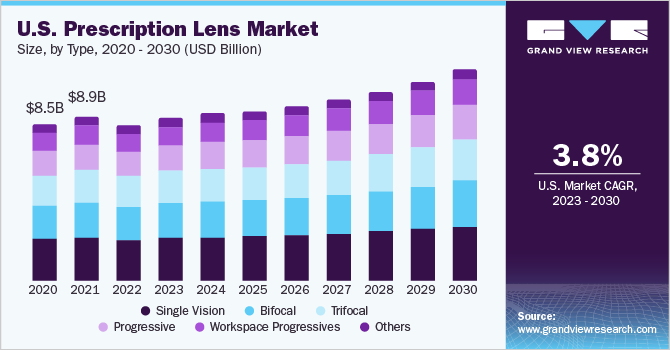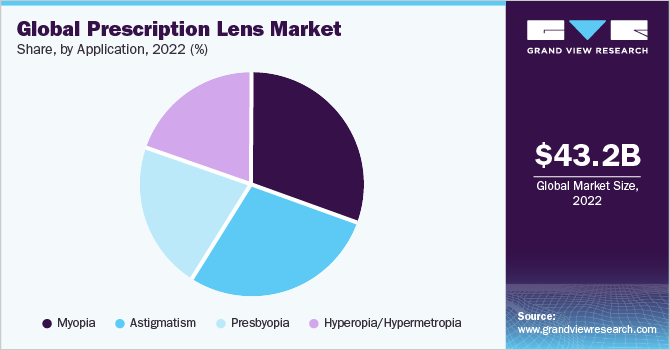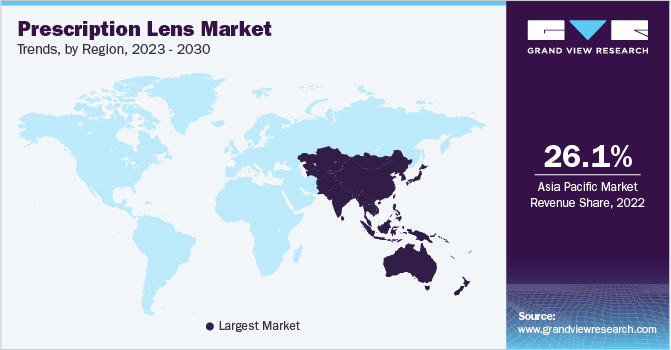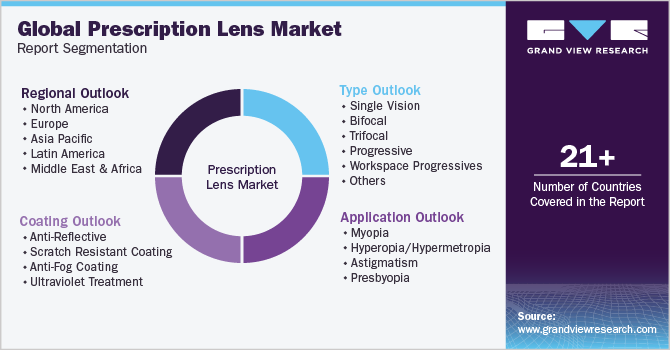- Home
- »
- Medical Devices
- »
-
Prescription Lens Market Size, Share & Growth Report, 2030GVR Report cover
![Prescription Lens Market Size, Share & Trends Report]()
Prescription Lens Market Size, Share & Trends Analysis Report By Type (Single Vision, Bifocal, Trifocal), By Application (Myopia, Astigmatism), By Coating, By Region, And Segment Forecasts, 2023 - 2030
- Report ID: GVR-4-68038-763-6
- Number of Pages: 140
- Format: Electronic (PDF)
- Historical Range: 2018 - 2021
- Industry: Healthcare
Report Overview
The global prescription lens market size was valued at USD 43.2 billion in 2022 and is anticipated to grow at a compound annual growth rate (CAGR) of 5.1% from 2023 to 2030. The incidence of vision impairment resulting from refractive errors is experiencing an upward trend. A significant portion of these cases goes undetected in the initial stages, contributing to the growing number of uncorrected refractive errors (URE). Patients affected by refractive errors often remain unaware of their condition and do not receive appropriate treatment. In order to address the escalating prevalence of URE, several organizations are being established with a specific focus on the detection and treatment of refractive errors.

The COVID-19 pandemic had an adverse effect on the prescription lens market. The absence of skilled laborers such as engineers and floor managers created a void in process control and production workflows, leading to quality issues while manufacturing contact lenses, prescription lenses, glasses, and frames. In addition, the market supply chain was immensely affected in several countries including China, Germany, India, and the U.S.
The growing prevalence of refractive error cases, mainly myopia and astigmatism, is expected to drive the demand for prescription lenses. Prescription lenses help in resolving the inability of the eyes to project light on the retina for enhanced vision. These lenses are available in different shapes and coatings and are preferred as per the refractive order. Convex prescription lenses are used for correcting hyperopia, concave prescription lenses are used for correcting myopia, and cylindrical prescription lenses are used for astigmatism.
Sightsavers, an organization that works in more than 30 countries, focuses mainly on African and Asian regions. The organization forms an alliance with local, regional, national, international partners, and governments to provide advanced and affordable ophthalmic treatment. The organization has come up with a refractive error strategy to address the problem of URE. The organization is providing refractive error services in line with its twin-track approach. In addition, the organization is expanding its program partnerships and is forming collaborations to enhance the services for URE. The presence of such organizations and growing awareness regarding the treatment of refractive errors are expected to drive the market.
Various eye conditions occur in people working for hours in front of computers. Therefore, companies are coming up with advanced technology to enhance prescription lens, which can protect the individual from harmful radiation of the computer. Market players like GUNNAR Optiks provide prescription lenses designed specifically for computer use. These lenses are developed using blue light blocking technology along with other lens technologies. The development of such technologically advanced prescription lenses is expected to contribute to the overall market growth.
Along with the incorporation of advanced technologies and the development of enhanced prescription lenses, the presence of online platforms for vision testing is expected to boost market growth. Online vision testing is one of the effective steps taken by the market players to make vision care accessible and convenient. These online tests are expected to help in the rapid diagnosis of refractive errors and hence will propel the adoption of prescription lenses for its treatment.
Type Insights
The single vision prescription lens segment dominated the market with the largest revenue share of 27.2% in 2022. People aged above 40 years mainly prefer single vision prescription lenses over bifocal, trifocal, and progressive lenses. Single vision prescription lenses are preferred as an effective option for reading and computer work as they help in maintaining concentration during work, thus avoiding the chance of developing computer vision syndrome. Additionally, single vision lenses help in enhancing peripheral vision, which can be a problem with bifocal, trifocal, and progressive lenses. However, the development of advanced and efficient progressive lenses with a wider field of view and better clarity can impact segment growth during the forecast period.
The progressive lens segment is expected to grow at the fastest CAGR of 5.8% over the forecast period from 2023 to 2030. Progressive lenses are also termed no-line bifocal lenses due to the absence of a visible bifocal line. Its youthful appearance and effective functionality make it one of the most preferred prescription lenses. Additionally, people with myopia, hyperopia, astigmatism, and presbyopia opt for progressive lenses. Furthermore, progressive lenses provide enhanced image quality as it eliminates the image jump observed with bifocals and trifocals lenses.
The workspace progressive lens segment is expected to grow at a lucrative CAGR over the forecast period from 2023 to 2030. The working population is growing tremendously, and its long exposure to various devices such as computers, tablets, laptops, and other electronic devices may strain the eyes and hence may lead to vision problems. Thus, to avoid such optical conditions and make work more efficient and comfortable, market players have come up with workspace progressives. These workspace progressives offer a large field of vision from near to an intermediate distance. ZEISS provides four versions of workspace progressive or office progressive lenses, which are near office lens, room office lens, NEW-book office lens, and the individual office lens. Therefore, awareness regarding the usage of office progressive lenses to avoid refractive errors is expected to drive the adoption of these lenses.
Application Insights
The myopia segment dominated the market with the largest revenue share of 30.7% in 2022. The global prevalence of myopia is high and it is expected to grow during the forecast period. According to a report by the World Health Organization, the prevalence of myopia in 2020 was 33% globally, which is expected to grow to 52% by 2050. The highest prevalence of the disease is observed in East Asia under which China, the Republic of Korea, Japan, and Singapore held around 50% of the regional share. Institutes are being developed to control the rise of myopia by increasing awareness regarding its preventive measures. The rising prevalence of myopia is projected to fuel market growth over the forecast period. For instance, according to the Investigative Ophthalmology and Visual Science journal, around 1.9 billion people were suffering from myopia and about 70 million had severe myopia in 2019 across the globe.

The presbyopia segment is expected to grow at the fastest CAGR of 5.4% during the forecast period from 2023 to 2030. Presbyopia develops with an increase in age and blurs vision. The growing aging population is one of the major factors fueling the growth of this segment. Companies such as Essilor and ZEISS are developing advanced prescription lenses for the treatment of presbyopia. Essilor has launched the VARILUX progressive lens by incorporating various advanced features and technologies such as SynchronEyes, Wavefront Advanced Vision Enhancement, 4D Technology, and Nanoptix for treating refractive errors such as presbyopia.
The hyperopia segment is expected to grow at a lucrative CAGR during the forecast period. Hyperopia is mainly prevalent among young children. According to a report by the Centers for Disease Control and Prevention (CDC),hyperopia affects a substantial number of people, with over 14 million individuals in the U.S. experiencing this refractive error. Early detection and treatment of hyperopia are important as moderate and high degrees of this disorder may lead to other visual impairment disorders. Hence, market players are developing prescription lenses for treating hyperopia. Convex lenses are among the most preferred solutions for restoring vision problems. Furthermore, convex lenses with anti-reflective coating are among the best set of prescription lenses to be used by a person having hyperopia.
Coating Insights
The anti-reflective (AR) coating segment dominated the market with the largest revenue share of 30.1% in 2022. Anti-reflective coating lenses are mainly preferred due to various advantages associated with them such as protection from harmful rays from electronic display screens. AR coating helps in eliminating the reflections, reduces contrast, and enhances clarity. Thus, AR coating lenses are largely preferred during nighttime. In addition, these lenses are nearly invisible, which helps in avoiding any distractions through lenses. ZEISS Group, a provider of ophthalmic products and solutions, launched DuraVision Premium lens coatings, which incorporate ion technology and many advanced features, which makes the lens surface tougher and resistant to damage and light reflections.
The ultraviolet (UV) treatment lens segment is expected to grow at the fastest CAGR of 5.5% during the forecast period from 2023 to 2030. Exposure to UV radiation has led to various eye disorders such as cataracts and macular degeneration. Therefore, people prefer UV-coated lenses to avoid visual impairment disorders. Polycarbonate and the high-index plastics used for making these UV treatment lenses absorb the radiation and protect the eye from harmful radiation. Some UV lenses come along with photochromic treatment. This darkens the lenses when exposed to UV radiations and high-energy visible (HEV) light rays and becomes clearer when indoors. Market players are focusing on developing UV protection prescription lenses for enhanced vision. Essilor’s Crizal range of products comes with UV protection coating to enhance single vision and progressive lenses. The company has developed Eye-Sun Protection Factor (E-SPF) for certifying UV protection to the eye and skin surrounding it.
The scratch resistant coating segment is expected to grow at a lucrative CAGR over the forecast period from 2023 to 2030 owing to the growing demand for clear and scratch-free lenses in physical and delicate work applications. The materials or plastic used for making advanced prescription lenses are prone to scratches. Hence, these lenses require coatings, which can protect these lenses from scratches. Scratch-resistant coated prescription glasses provide a clearer vision for a long duration and thus have a prolonged lifespan. People with an active lifestyle such as sports or are engaged in various outdoor activities largely prefer prescription lenses with this coating.
Regional Insights
Asia Pacific dominated theprescription lens market with the largest revenue share of 26.1% in 2022 and is also expected to grow at the fastest CAGR of 7.7% over the forecast period from 2023 to 2030. Countries such as China, Japan, Singapore, and the Republic of Korea account for a 50% share of myopia prevalence worldwide. The growing prevalence of refractive errors in the region is increasing the number of patients, and hence is creating demand for prescription lenses for its treatment. Market players located in the region are undergoing strategic alliances to expand their prescription lens business. For instance, in October 2021, HOYA, an optical technology innovation company, announced a partnership with Orbis. HOYA will actively collaborate with Orbis to fulfill its mission of reducing inequalities in vision health. This collaboration involves promoting eye-care services, extending access to sight-saving interventions in communities worldwide, and enhancing eye-health literacy and education. Through these concentrated efforts, HOYA aims to contribute to the noble cause of ensuring equal access to vision care for all.

North America held a significant revenue share in 2022 owing to the increasing prevalence of myopia and presbyopia in countries such as the U.S. and Canada. Furthermore, major market players are present in the region and are launching prescription lenses with advanced features. For instance, in October 2018, Privé Revaux announced the launch of prescription lenses at a reasonable price. The company has also expanded its reach to the patient pool by providing online vision tests through its partnership with Opternative, a technology company. The increasing adoption of advanced technology and products in the region is contributing to the overall market growth.
Europe is expected to grow at a lucrative CAGR during the forecast period from 2023 to 2030. The presence of organizations and societies for preventing visual impairment is expected to drive the market in Europe. The International Agency for the Prevention of Blindness (IAPB) along with the WHO launched a joint program, VISION 2020: The Right to Sight, for eliminating blindness by focusing on the diseases, which mainly cause vision impairment such as refractive errors. Therefore, growing awareness in the region and the adoption of treatment options such as prescription lenses for refractive errors are expected to propel the market growth in Europe.
Key Companies & Market Share Insights
The rise in competition is leading to rapid technological advancements and companies are constantly working towards the improvement of their products with a major focus on research and development. Factors such as investment in research & development, compliance with regulatory policies, and technological advancements are constantly driving the introduction of novel techniques. Major players are focusing on developing different types of prescription lenses with different coating options.
These players are undertaking initiatives such as partnerships, mergers, acquisitions, and product launches to expand their product reach and improve their product offerings. For instance, in July 2023, Vision Rx Lab announced the launch of Nova Ai Artificial Intelligence Lenses. It offers a comfortable optical experience, with customized progressive lenses created for each individual's particular style of looking, and is driven by cutting-edge optical technology and AI. Tailored to the specific visual needs of each individual, personalized progressive lenses leverage state-of-the-art optical technology and artificial intelligence (AI) to deliver a personalized and seamless optical experience for discerning consumers.
Similarly, in January 2023, Essilor announced the launch of the Essilor Stellest lens to slow down the progression of myopia among children in India. The company claimed that clinical trial results showed that the lens slowed down myopia progression by 67 percent on average, compared to single vision lenses, when worn 12 hours a day. In another instance, in July 2021, Essilor announced the launch of a progressive web app version of the pre-existing Essilor Companion for all eye care professionals. This initiative aims to streamline the digital ecosystem for Essilor’s industry partners, including Eye Care Professionals (ECPs), and offers a superior in-store digital Essilor brand experience. Some of the prominent key industry players operating in the global prescription lens market include:
-
Essilor
-
ZEISS Group
-
HOYA
-
VISION EASE
-
SEIKO OPTICAL PRODUCTS CO., LTD.
-
Privé Revaux
-
Vision Rx Lab
Prescription Lens Market Report Scope
Report Attribute
Details
Market size value in 2023
USD 46.1 billion
Revenue forecast 2030
USD 65.4 billion
Growth rate
CAGR of 5.1% from 2023 to 2030
Base year for estimation
2022
Historical data
2018 - 2021
Forecast period
2023 - 2030
Quantitative units
Revenue in USD million and CAGR from 2023 to 2030
Report coverage
Revenue forecast, company ranking, competitive landscape, growth factors, and trends
Segments covered
Type, application, coating, region
Regional scope
North America; Europe; Asia Pacific; Latin America; MEA
Country scope
U.S.; Canada; UK; Germany; France; Italy; Spain; Denmark; Sweden; Norway; Japan; China; India; Australia; South Korea; Thailand; Brazil; Mexico; Argentina; Saudi Arabia; South Africa; UAE; Kuwait
Key companies profiled
Essilor; ZEISS Group; HOYA; VISION EASE; SEIKO OPTICAL PRODUCTS CO., LTD.; Privé Revaux; Vision Rx Lab
Customization scope
Free report customization (equivalent up to 8 analyst’s working days) with purchase. Addition or alteration to country, regional & segment scope
Pricing and purchase options
Avail customized purchase options to meet your exact research needs. Explore purchase options
Global Prescription Lens Market Report Segmentation
This report forecasts revenue growth at global, regional, and country levels and provides an analysis of the latest industry trends in each of the sub-segments from 2018 to 2030. For the purpose of this study, Grand View Research has segmented the global prescription lens marketon the basis of type, application, coating and region:

-
Type Outlook (Revenue in USD Million, 2018 - 2030)
-
Single Vision
-
Convex
-
Concave
-
Cylindrical
-
-
Bifocal
-
Trifocal
-
Progressive
-
Workspace Progressives
-
Others
-
-
Application Outlook (Revenue in USD Million, 2018 - 2030)
-
Myopia
-
Hyperopia/Hypermetropia
-
Astigmatism
-
Presbyopia
-
-
Coating Outlook (Revenue in USD Million, 2018 - 2030)
-
Anti-Reflective
-
Scratch Resistant Coating
-
Anti-Fog Coating
-
Ultraviolet Treatment
-
-
Regional Outlook (Revenue in USD Million, 2018 - 2030)
-
North America
-
U.S.
-
Canada
-
-
Europe
-
UK
-
Germany
-
France
-
Italy
-
Spain
-
Denmark
-
Sweden
-
Norway
-
-
Asia Pacific
-
Japan
-
China
-
India
-
Australia
-
Thailand
-
South Korea
-
-
Latin America
-
Brazil
-
Mexico
-
Argentina
-
-
Middle East & Africa
-
South Africa
-
Saudi Arabia
-
UAE
-
Kuwait
-
-
Frequently Asked Questions About This Report
b. The global prescription lenses market size was estimated at USD 43.2 billion in 2022 and is expected to reach USD 46.1 billion in 2023.
b. The global prescription lenses market is expected to grow at a compound annual growth rate of 5.1% from 2023 to 2030 to reach USD 65.4 billion by 2030.
b. North America dominated the prescription lenses market with a share of 25.0% in 2022. This is attributable to the growing prevalence of refractive errors in the region and the growing adoption of technologically advanced prescription lenses.
b. Some key players operating in the prescription lenses market include EssilorLuxottica, ZEISS International, HOYA VISION CARE COMPANY, VISION EASE, SEIKO OPTICAL PRODUCTS CO., LTD, and Vision Rx Lab.
b. Key factors that are driving the prescription lenses market growth include the growing prevalence of refractive errors, a growing number of awareness programs, and a growing number of product launches.
Share this report with your colleague or friend.
![gvr icn]()
NEED A CUSTOM REPORT?
We can customize every report - free of charge - including purchasing stand-alone sections or country-level reports, as well as offer affordable discounts for start-ups & universities. Contact us now
![Certified Icon]()
We are GDPR and CCPA compliant! Your transaction & personal information is safe and secure. For more details, please read our privacy policy.
We are committed towards customer satisfaction, and quality service.
"The quality of research they have done for us has been excellent."





